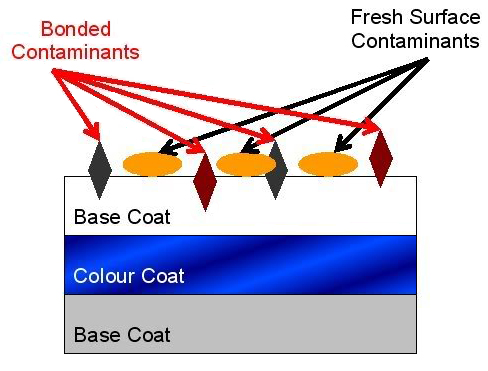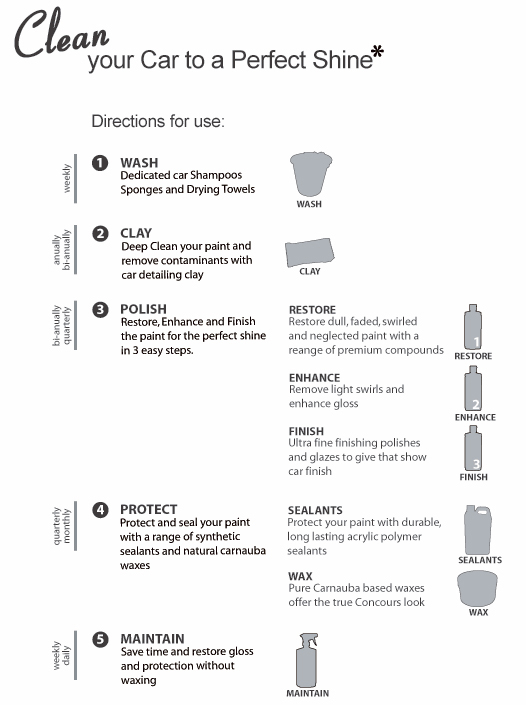Frequently Asked Questions
What Is Car Paint Correction?
Also known as swirl mark removal or machine polishing, paintwork correction is the reduction or removal of marks in the top layer of paint to produce a more refined finish.
Paint correction can involve either the hand or machine application of varying grades of cleanser, polish or compound. The majority of work is usually done with rotary machine polishers to get the best level of correction.
Good paint correction requires a high degree of skill and concentration, but done properly, it really can transform the look of a car by dealing with (amongst other things); hard water marks, etching caused by bird muck or fly squash, swirl marks, scratches and fading.
Done professionally, paint correction is entirely safe and will not cause any issues for your paint.
Why Consider Paint Correction?
A car's paint has to deal with a lot of environmental challenges:
- Road grime and grit
- Bird muck, fly squash and tree sap
- Tar
- Water spots
- People brushing against the car with their clothing or bags
- Poor valeting techniques and/or products
- Poor machine or hand polishing techniques
- Auto car washes
Sadly all of these things can leave the finish of a car looking less than perfect and at worst, dull, faded and covered in light scratches, swirls and other marring. Not only does this detract from your car's appearance but it ultimately reduces its value as well.
For the vast majority of cars, paint correction really can make a substantial difference and will completely remove or significantly reduce most marks. Not only this, but the resulting finish will have an amazing gloss, depth of reflection and slickness.

This simple diagram illustrates the typical make up of modern car paint where the topmost clearcoat layer contains a number of marks or scratches.
The red dotted line provides an example of where the clearcoat may be reduced to following polishing. As illustrated, some marks will have been completely removed while others will have been made much smaller and are likely to be harder to see.
The number of marks removed depends on the existing safe levels of paint and which paint correction service is chosen.
Detarring
During warm weather/winter conditions the road surface can disintegrate and small specks of tar are flicked onto your bodywork. These spots show up especially well on light coloured cars and can ruin otherwise perfect paint.
Tar Remover will also remove adhesive residues, fuel stains from paintwork and tree sap.
This will now leave a perfect base to start glazing, polishing, sealing or waxing your vehicle
What Is Detailing Clay?
While clay is growing in popularity with many detailers now, it has certainly not become a well known "household" car detailing product. Detailing clay is a substance that is designed to remove bonded contaminatns from paint, leaving the paint smooth as glass, allowing easier and more fruitful applications of polihses, glazes, sealents and waxes. Detailing Clay is wiped gently across the paint which needs to be lubricated with a lubricant such as a Quick Detailer spray.
Clay, like polishes, comes in levels of aggressiveness - if you are a beginner with clay, do start with a mild clay such as Meguiars Quik Clay, Meguiars Professional Mirror Glaze Clay (mild, the blue bar) or Sonus Green Clay. These mild clays should be enough to remove bonded contaminants from most cars, only step up to a more aggressive clay if absolutely needed.
Clay can be used on paintwork, glass, and wheels. Always use separate clay on each - ie don't first clay your wheels then use the same clay to clay your paint, as all the brake dust embedded in the clay from the wheels will scratch the paint.
What Are Bonded Contaminants?
When you come to wash your car, the paint will be covered in lots of fresh contiaminats such as dust, mud, possibly bird boms and many others. In addition, the paint will also have a growing amount of bonded contaminants attached to it, which accumulate over time:

When you wash your car, the fresh contaminants are removed from the paint and the paintwork looks clean. However, washing will leave behine the bonded contaminats which are attached to the paint as if they had been glued on:

These bonded contaminats are hard to see, so after washing your paintwork looks clean. However, if you gently run your fingers across the paintwork you may feel that the paintwork feels rough - a bit like stubble in a way. This roughness, grittiness that you are feeling is the bonded contaminants in the paint.
Examples of bonded contaminants are:
- > Brake dust - sharp, so embeds itself in the paint
- > Industrial fallout
- > Tree sap - very sticky so adheres strongly to the paint
and there are many others as well which you're car is subjected to on a regular basis.
Removing Bonded Contaminants - Clay
In order to remove the bonded contaminats and restore a glassy smooth feel to the paint, detailing clay is used. As well as leaving a pleasingly smooth feel to the paint, when you come to polish, glaze, seal or wax, it means that you are now sealing in remaining bonded contaminants if you have removed them by clay. Simply washing and waxing will not remove bonded contaminants, they will be left behind and then just waxed over.
Clay basically works by grabbing hold of the bonded contaminants and pulling them off of the paint surface:

The contmainats become stuck in the softer clay where they remain. A safety note when using clay here - these bonded contaminats are stuck into the clay and the clay represents a flat surface. Therefore, surface marring can occur if not enough lubricant is used, or the clay is not kneaded regularly enough to a clean side - please see also the section on using clay...
This leaves the paint finish glassy smooth. Clay can remove the bonded contaminants listed above, however some adhesive contaminants such as tar may need a dedicated tar remover as they are very highly adhesive.
Using Clay
Before claying, always wash fresh contaminants off of the car. First and foremost, always follow the manufacturers instruction for the correct use of their detailing clay. What follows here is a generic guide of tips for the safe use of clay which I use from experience of using clay.
To clay your car, you will need a clay bar and an associated lubricant to lubricate the surface and the clay bar - examples of such lubricants are:
- > Meguiars Quick Detailer Spray
- > Meguiars Last Touch Detailing Spray
- > Meguiars #34 Final Inspection
- > Clearkote Clay Lubricant
- > Pinnacle Poly Clay Lubricant
and there are others that can be used too.
About 40 - 50g of clay is sufficient to clay a moderately sized car. If using Meguiars Quick clay, for example, break off one third to one half of the clay bar (the bigger the car, the more clay you may need).
Roll the clay up into a ball, then out into a sausage shape and finally flatten it out into the palm of your hand. When doing this ensure that the clay is warm and quite soft. It clay gets cold, it can be hard or brittle and this can risk inducing surface marring on the paint. Throughout the claying process, always ensure that the clay remains nice and warm and doesn't go brittle or hard.
Work on small areas at a time, I start with the roof, and then the bonnet, then the top half of the sides, then the boot, then the bottom half of the sides (like washing, do the cleaner areas first). I always spray a panel with quick detailer and wipe off before claying it to remove and rogue dust particles that may have blown onto the paint that may induce marring.
Work on small areas of paintwork at a time - about 2' by 2'. Spray the area with the clay lubricant, enough to wet the surface quite thoroughly. Also spray the clay with lubricant as well. Gently wipe the clay in a fore and aft motion over the lubricated area using only finger light pressure:

Never clay over a dry area of paint, and if the paint begins to dry out before you are happy that the surface contaminants have been removed (paint will feel smooth), spray on more lubricant. Keep the clay lubricated as well. Once the paintwork feels smooth, gently wipe the remaining clay lubricant away using a soft microfibre towel.
Knead the clay very regularly - this not only keeps the clay warm, but when kneading expose a clean side of the clay. Remember that clay is picking up sharp particles, if you do the whole car with one side of clay you will induce surface marring as all the sharp particles stuck in the clay will inevitably come into contact with the paint. For this reason, knead the clay regularly and only ever use finger light pressure. When a clean side of clay can no longer be revealed, discard the clay.
Continue until the car is completed. Note that many clays will remove some or all (depending on aggressiveness) of the wax/sealent protection, so always follow up claying with polishing and glazing if required, followed by sealing and/or waxing.
Some Notes on Safe Clay Use
Clay is safe to use if used with care. However, if not used with care it can induce surface marring.
Always regularly knead the clay to a clean side.
Always keep both the clay and the paint surface well lubricated.
Use only finger light pressure
If you drop the clay on the ground, discard it as it will pick up tons of dust and grit and dirt from the ground that will inflict damage to paint.
Keep clay warm, and supple - if it gets cold, hard and brittle it will induce marring, so another reason to keep kneading regularly, especially in winter.

Why Protect Paint?
The paintwork on you car is there not only to look nice but to protect the underlying metal work as well. However, paintworlk requires protection of its own as well. Its like the skin of your car and it is continuously subjected to contaminants and environmental harm when its outside:

Examples of these contaminants are:
- > Ultraviolet Radiation (UV) from sunlight - you cannot see UV, can cause fading
- > Rain - rain water is actually a contaminant which can also be filled with polution and acids
- > Bird bombs - highly alkaline and can eat into the finish of your paint
- > Industrial Fallout
- > Road film
- > Salts (road salts are very bad for paint, and can cause corrosion on metal)
- > General muck and grime
The chances are that you may have just spent many hours washing, and removing defects from your paint and glazing it to get that sought after wet look shine, but it is necessary to protect that finish with a hardwearing layer in order to keep the finish looking at its best, otherwise the elements above will degrade and damage the paintfinish. So a protective barrier is applied to the paint:

Now, its the protectivbe barrier which is subjected to the elements and not the paint. The protective barrier will be eaten away over time by the elements and will need to be replaced, but its far cheaper to replace the protective barrier than to replace the paint!!
Back to Top


